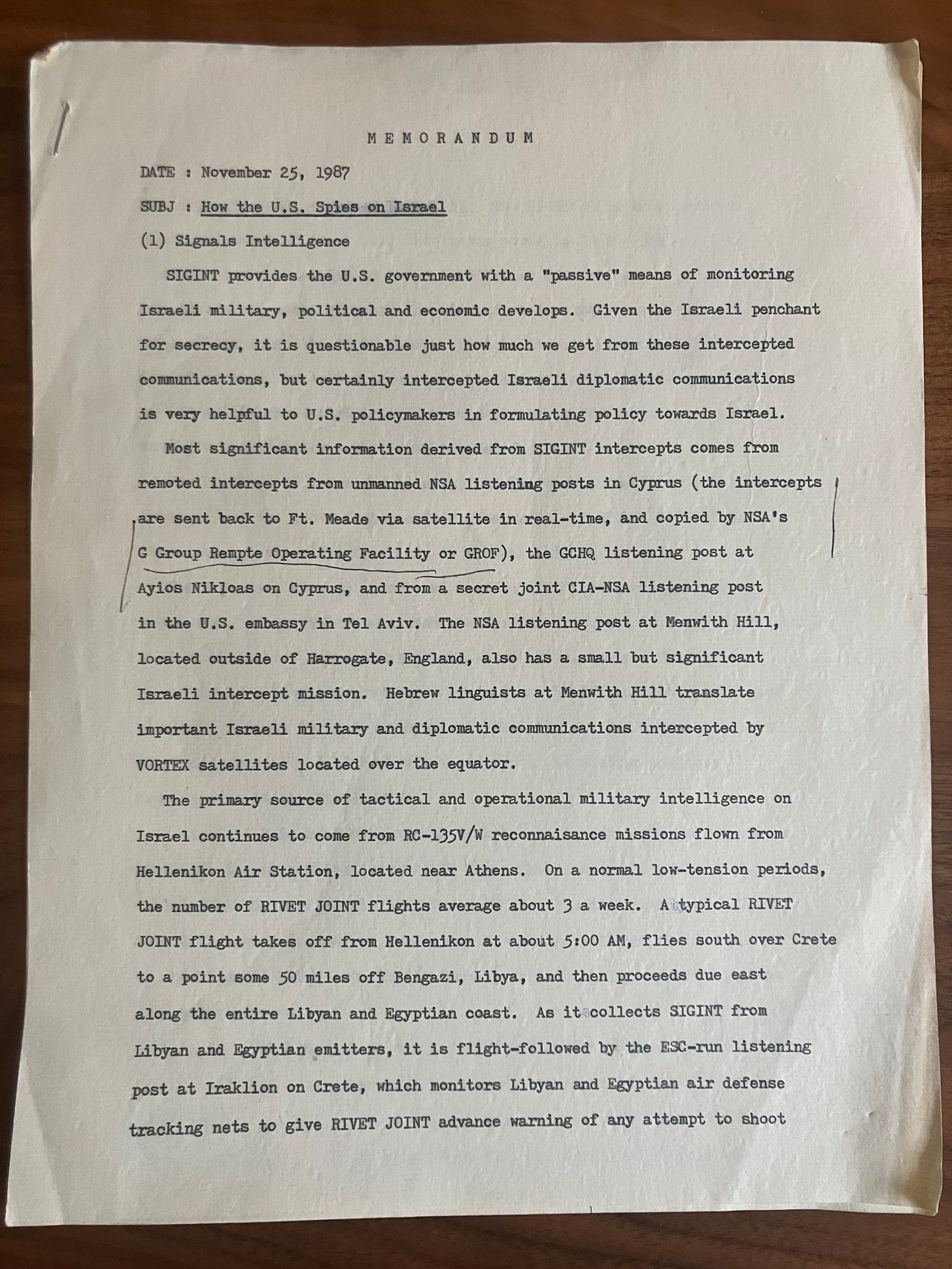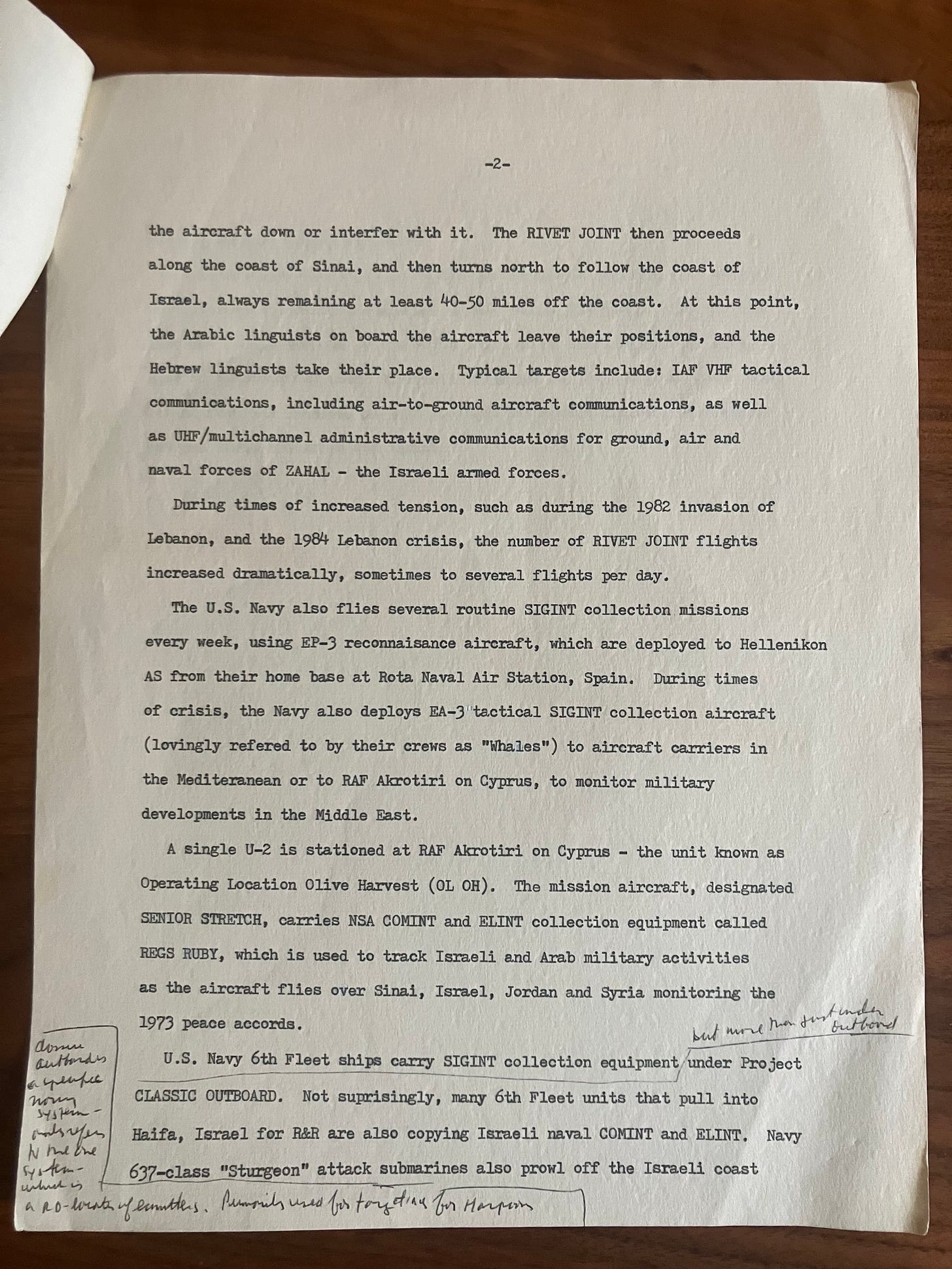Notes from the annals of American surveillance in the Mediterranean
I abhor the word “dystopia,” commonly defined as an imaginary realm plagued by injustice, strife, and disaster. But we in the United States are living through an all too real dystopia, and not only in terms of the bleak presidential race that is leaving so many Americans saying, in essence: “Is this all we got?”
The other reality is the increasingly clear prospect, horrifying as it may be, that there will be no relenting in Israel’s destruction of Gaza and its recasting of the West Bank as an Israeli-dominated suburb of Tel Aviv and Jerusalem.
The best America can offer, alongside our bombs and other weapons still flowing to Israel, are air-dropped military MREs (meals ready-to-eat); a president who babbles about an imminent ceasefire without applying sufficient pressure to make one happen; and a vice-president who is sent out publicly to urge Hamas—not Israel—to agree to a six-week ceasefire in Gaza. Fat chance.
Two Sundays ago Israeli Prime Minister Benjamin Netanyahu went on CBS’s Face the Nation and dismissed out of hand any immediate chance of a settlement with Hamas. “Hamas started out with just crazy demands,” he said of the number of Hamas prisoners to be released by Israel in return for the freeing of Israeli hostages. “I don’t think it makes any sense to have a public discussion of this . . . it’s too soon to say . . . if they’ve abandoned them and get into what you call the ballpark, they’re not even in the city. They’re in another planet.” The Israeli leader insisted: “Victory is within reach, and you can’t have victory until you eliminate Hamas.”
The American intelligence community has reason to believe, so I have been told, that it and Netanyahu know a great deal more than has been said publicly about the state of Hamas’s Israeli hostages—that is, those still believed to be alive, who are the central incentive for Israel to consider a ceasefire agreement. Thursday will mark five months of their captivity.
The talk of a renewed ceasefire agreement comes at a time, a well-informed American adviser told me, when the Israeli Defense Forces are working their way closer to Yahya Sinwar, the Hamas leader and mastermind of the October 7 attacks. Sinwar is holding out in a vast tunnel complex in southern Gaza. Killing Sinwar is now the priority for Netanyahu. The prime minister is in the unique position of being reviled by a majority of Israelis who nevertheless remain overwhelmingly supportive of his policy of eliminating the possibility of meaningful Palestinian control in Gaza and the West Bank.
Bibi and his colleagues running war policy, the adviser said, are “dedicated to protecting the Jewish people, whether in Israel or America or wherever. Protecting Jewishness is his highest objective. Israelis fight each other on all other issues, except when they are threatened. Hamas violated a cardinal rule: ‘You cannot kill Jewish people.’
“There is no limit to that rule,” he said. “If Iran were to develop a nuclear weapon”—there is no evidence it has yet done so, the adviser quickly added—“Israel would use a nuclear weapon” to destroy Iran’s nuclear facility. “Everyone who has grown up in Israel knows such.
“Sinwar is said to be in negotiation with the IDF,” the adviser said. “Do you really think there will be a ceasefire? They may stop the shooting but it will not be an end to the war. You don’t get the IDF soldiers willing to do what they are doing without being dedicated to the man. Jewishness is the highest objective. They all believe their very existence is at stake.”
In terms of an assessment of the chance of a significant agreement between Israel and Hamas, the best I can do is report that the American intelligence community and at least some in the White House have much more relevant and skeptical intelligence than is being relayed to the public. The American community has no shortage of technical means, including satellites, of sweeping up vast amounts of data and sorting that data for relevance.
Decades ago, while writing a book, The Samson Option, on the Israeli bomb and how America helped turn Israel into a nuclear power, I was given an inside summary (posted in full below) entitled “How the U.S. Spies on Israel” by a source within the National Security Agency. I did not write about the material in it at the time, because of obvious security reasons, but the specific data in the summary, while relevant to what we do today, is no longer timely, or classified.
The point of making this material public is not to interfere with Israel’s capability to spy electronically on others, or with America’s ability to do the same and counter such capability—let those billion-dollar games continue—but to suggest just how much America knows today about the hostage situation inside the tunnels of Hamas.
The paper states: “Given the Israeli penchant for secrecy, it is questionable just how much we get from these intercepted communications, but certainly intercepted Israeli diplomatic communications [are] very helpful to U.S. policymakers in formulating policy toward Israel.”
The next paragraph discusses various American facilities that were involved in the intercepts, including a number of unmanned listening posts in the Eastern Mediterranean whose data was eventually relayed to the headquarters of the NSA in suburban Maryland. There were also joint NSA-CIA listening facilities, known as cells, tucked deep inside American embassies all over the world, including in Israel. Another important interception post was in Menwith Hill, a Royal Air Force base north of Leeds, in England, where Hebrew linguists monitored data picked up by satellite.
A further source of intercepts came via a long-standing reconnaissance program involving Air Force Rivet joint flights—modified Boeing 707 aircraft that operate all over the world on behalf of the NSA. (One such flight was overhead in the Baltic Sea in case of a crisis in the fall of 2022 when a CIA team triggered a series of bombs that destroyed three of the four Nord Stream pipelines meant to relay cheap Russian gas to Germany.) The Rivet Joint flights were a main source of tactical intelligence about Israel decades ago, but I do not know whether they have been supplanted by satellite collection programs. In their heyday, however, at least three such flights took place every week, and at greater frequency in times of crisis, flying from a base near Athens over Crete to the coasts of Libya and Egypt, collecting data in Arabic all the way. As the plane neared Israel, according to the document I have, “the Arab linguists on board the aircraft leave their positions, and the Hebrew linguists take their place.” Typical targets of the linguists included “administrative communication for ground, air and naval forces” of the Israeli armed forces.
The US Navy also played a significant role in intercepting Israeli communications. In times of crisis, the document notes, special Navy sigint aircraft, known as “whales,” were flown to the Navy’s aircraft carriers in the Mediterranean. The Navy’s 6th Fleet, headquartered in Naples, Italy, were equipped with the most advanced NSA interception equipment, and copied away when they made port in Haifa, Israel. Navy attack submarines, called “sturgeons,” were assigned to “prowl off the Israeli coast” in time of crisis copying Israeli diplomatic and military traffic.
Of course, many of the specific interception techniques have been upgraded and made more efficient in the ability to spy, but the vast amount of Israeli signals and messages that can be intercepted, even if encoded, and put to tactical use surely has put some offices in America into specific knowledge about how many of the separated Israeli IDF male and female hostages are still alive. It is also known that the IDF leadership has gone to extreme means, in terms of risking lives, to collect real-time intelligence about the status of its prisoners inside the Hamas tunnel system.
The inevitable endgame in Gaza is coming. The Israeli leadership, defying the ongoing protests from the families of those taken on October 7, seems to be in no rush to negotiate a ceasefire deal, exchanging hostages for jailed Palestinians. Why not?
DOCUMENT:
HOW THE U.S. SPIES ON ISRAEL
NOVEMBER 25, 1987




No comments:
Post a Comment